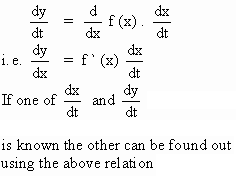|
5.14 Related Rates
We have seen that  is
the derivative of s (t) w. r. to t and can be interpreted as the velocity. is
the derivative of s (t) w. r. to t and can be interpreted as the velocity.
This physical interpretation can be extended further.
If (x, y) are the co-ordinates of a moving particle then both x and y are functions of ’ t ’.
 , then, is the rate of change of x w. r. to ’ t ’ and
, then, is the rate of change of x w. r. to ’ t ’ and  is
the rate of change of y w. r. to ’ t’ is
the rate of change of y w. r. to ’ t’
 since
both x and y are related by a function y = f (x), since
both x and y are related by a function y = f (x), are also related. If one of is known the other can be found using the relation
between these rates.
are also related. If one of is known the other can be found using the relation
between these rates.
Problem of this type are known as problem of related rates.
Technique : y = f (x) where both x and y are dependent on time ' t '
Hence 
[next page]
|